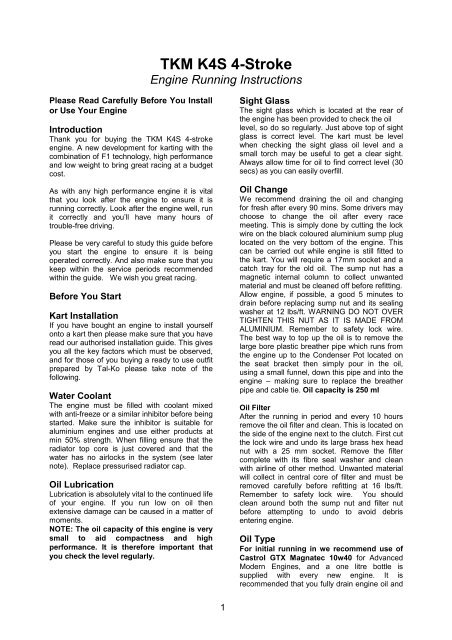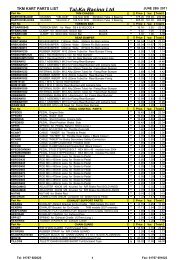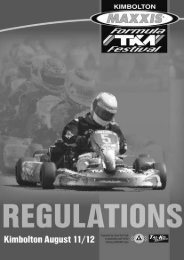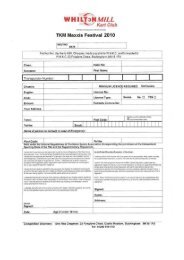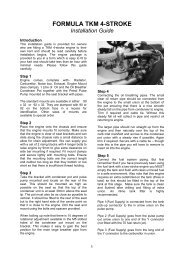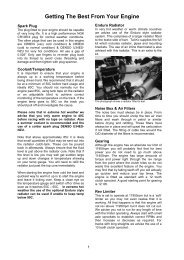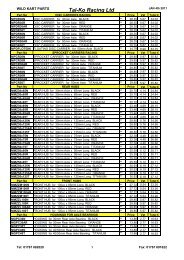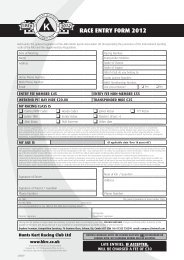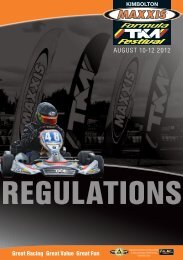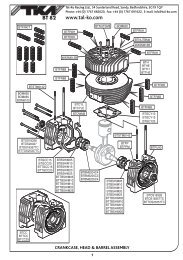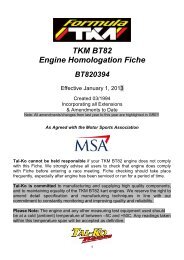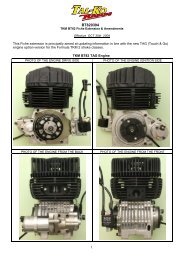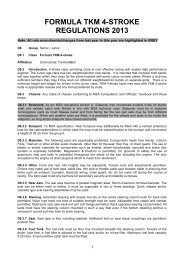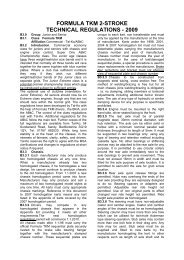You also want an ePaper? Increase the reach of your titles
YUMPU automatically turns print PDFs into web optimized ePapers that Google loves.
TKM K4S 4-Stroke<br />
<strong>Engine</strong> <strong>Running</strong> <strong>Instructions</strong><br />
Please Read Carefully Before You Install<br />
or Use Your <strong>Engine</strong><br />
Introduction<br />
Thank you for buying the TKM K4S 4-stroke<br />
engine. A new development for karting with the<br />
combination of F1 technology, high performance<br />
and low weight to bring great racing at a budget<br />
cost.<br />
As with any high performance engine it is vital<br />
that you look after the engine to ensure it is<br />
running correctly. Look after the engine well, run<br />
it correctly and you’ll have many hours of<br />
trouble-free driving.<br />
Please be very careful to study this guide before<br />
you start the engine to ensure it is being<br />
operated correctly. And also make sure that you<br />
keep within the service periods recommended<br />
within the guide. We wish you great racing.<br />
Before You Start<br />
Kart Installation<br />
If you have bought an engine to install yourself<br />
onto a kart then please make sure that you have<br />
read our authorised installation guide. This gives<br />
you all the key factors which must be observed,<br />
and for those of you buying a ready to use outfit<br />
prepared by <strong>Tal</strong>-<strong>Ko</strong> please take note of the<br />
following.<br />
Water Coolant<br />
The engine must be filled with coolant mixed<br />
with anti-freeze or a similar inhibitor before being<br />
started. Make sure the inhibitor is suitable for<br />
aluminium engines and use either products at<br />
min 50% strength. When filling ensure that the<br />
radiator top core is just covered and that the<br />
water has no airlocks in the system (see later<br />
note). Replace pressurised radiator cap.<br />
Oil Lubrication<br />
Lubrication is absolutely vital to the continued life<br />
of your engine. If you run low on oil then<br />
extensive damage can be caused in a matter of<br />
moments.<br />
NOTE: The oil capacity of this engine is very<br />
small to aid compactness and high<br />
performance. It is therefore important that<br />
you check the level regularly.<br />
Sight Glass<br />
The sight glass which is located at the rear of<br />
the engine has been provided to check the oil<br />
level, so do so regularly. Just above top of sight<br />
glass is correct level. The kart must be level<br />
when checking the sight glass oil level and a<br />
small torch may be useful to get a clear sight.<br />
Always allow time for oil to find correct level (30<br />
secs) as you can easily overfill.<br />
Oil Change<br />
We recommend draining the oil and changing<br />
for fresh after every 90 mins. Some drivers may<br />
choose to change the oil after every race<br />
meeting. This is simply done by cutting the lock<br />
wire on the black coloured aluminium sump plug<br />
located on the very bottom of the engine. This<br />
can be carried out while engine is still fitted to<br />
the kart. You will require a 17mm socket and a<br />
catch tray for the old oil. The sump nut has a<br />
magnetic internal column to collect unwanted<br />
material and must be cleaned off before refitting.<br />
Allow engine, if possible, a good 5 minutes to<br />
drain before replacing sump nut and its sealing<br />
washer at 12 lbs/ft. WARNING DO NOT OVER<br />
TIGHTEN THIS NUT AS IT IS MADE FROM<br />
ALUMINIUM. Remember to safety lock wire.<br />
The best way to top up the oil is to remove the<br />
large bore plastic breather pipe which runs from<br />
the engine up to the Condenser Pot located on<br />
the seat bracket then simply pour in the oil,<br />
using a small funnel, down this pipe and into the<br />
engine – making sure to replace the breather<br />
pipe and cable tie. Oil capacity is 250 ml<br />
Oil Filter<br />
After the running in period and every 10 hours<br />
remove the oil filter and clean. This is located on<br />
the side of the engine next to the clutch. First cut<br />
the lock wire and undo its large brass hex head<br />
nut with a 25 mm socket. Remove the filter<br />
complete with its fibre seal washer and clean<br />
with airline of other method. Unwanted material<br />
will collect in central core of filter and must be<br />
removed carefully before refitting at 16 lbs/ft.<br />
Remember to safety lock wire. You should<br />
clean around both the sump nut and filter nut<br />
before attempting to undo to avoid debris<br />
entering engine.<br />
Oil Type<br />
For initial running in we recommend use of<br />
Castrol GTX Magnatec 10w40 for Advanced<br />
Modern <strong>Engine</strong>s, and a one litre bottle is<br />
supplied with every new engine. It is<br />
recommended that you fully drain engine oil and<br />
1
efill after 90 mins & 180 mins of running using<br />
this oil to complete the running in process and<br />
maybe first couple of races. After the running<br />
in period, for racing the use of Castrol EDGE<br />
Sport 0W-40 or other equivalent high<br />
specification synthetic oils is recommended. Do<br />
NOT use motor cycle oils.<br />
Oil Capacity<br />
You MUST ensure the engine is filled with oil to<br />
the maximum level before starting. From empty<br />
new engines will need 250ml of oil to bring the<br />
level to just above the top of the sight-glass.<br />
When carrying out regular oil changes, always<br />
add 250ml which should bring oil to correct<br />
levels. We do not recommend the use of fully<br />
synthetic oils for running in but do recommend<br />
after approx 4 hours of total running that you<br />
fully drain the engine oil and change to Castrol<br />
Edge Sport 0W-40 Fully Synthetic.<br />
Oil Condenser & Breather Assembly<br />
Always mount this assembly as high as possible<br />
on the rear seat in an upright position.<br />
This assembly allows oil in the engine to breathe<br />
via the large hose connected to rear of engine<br />
whilst running which then collects in the<br />
aluminium condenser pot and returns back via a<br />
small plastic pipe into the engine. This small<br />
pipe should always have a fall along its entire<br />
route to allow gravity to return oil back into the<br />
engine. Please note that the plastic oil catch<br />
bottle is screwed on and should be emptied and<br />
cleaned after each days racing. DO NOT pour<br />
any oil that is in this bottle back into engine as it<br />
is contaminated and may cause engine damage.<br />
This catch bottle can be drilled and a safety<br />
cable tie used to prevent bottle loss. On some<br />
tracks and conditions to prevent excessive oil<br />
loss in plastic oil catch bottle it is advised to use<br />
the alternative Enduro breather system.<br />
Fuel System<br />
Note that the fuel system has a supply pipe from<br />
the fuel tank together with a fuel return pipe<br />
system to take off excess fuel back to the tank.<br />
Fuel Pulse Pump<br />
The pulse pump mounted on the rear of the seat<br />
has arrows showing the direction of the fuel flow<br />
and pipes must be connected correctly. The fuel<br />
return pipe is connected to the plastic “Y” piece<br />
and has a size 70 restrictor fuel return jet fitted.<br />
This jet must not be removed. We recommend<br />
that an in line fuel filter is used in the fuel supply<br />
pipe to pulse pump.<br />
Carburettor<br />
At the factory the carburettor will have been set<br />
to give an approximate setting for first starting &<br />
running. However it will probably need the tick<br />
over speed fine tuning once first started.<br />
On the top of the carb is the small black plastic<br />
choke lever which can be pulled upright to give<br />
full choke. This should be used in the full choke<br />
position to first start the engine from cold. Do not<br />
depress the throttle when starting on choke as it<br />
may cause fuel flooding of the engine. Please<br />
note that the small black coloured overflow<br />
looped pipe on carb has a small cut split in its<br />
highest point which allows carb to vent. It must<br />
not be covered or blocked off.<br />
Carb Jetting<br />
As supplied the engine comes with a 122 main<br />
jet for Senior & 124 for Junior which is what we<br />
recommend for running in and most<br />
running/racing. However you may find that by<br />
changing to a slightly smaller or bigger jet it will<br />
give greater performance and crisper response,<br />
but this will depend on track and conditions. Only<br />
go down or up in main jet sizes a small amount<br />
at a time, i.e. from 124 to say 122 and so on.<br />
You can feel if you have gone too small on main<br />
jet by the engine holding back in a certain area<br />
of the rev range. If engine feels like it is holding<br />
back on standard jets try jetting up. For best<br />
carburation & running results we recommend<br />
that engine is raced at around a running temp of<br />
70 - 80C on standard radiator and 60 – 65C on<br />
Enduro radiator.<br />
To change the jet simply undo the large 14mm<br />
brass nut at very bottom of carb. Place a fuel<br />
catch pot just under this nut so the fuel in the<br />
float bowl is safely collected. Let engine exhaust<br />
pipe cool before you attempt this for safety.<br />
Remove the brass nut assembly into which is<br />
screwed the main jet. Hold brass nut in 14mm<br />
spanner and unscrew jet and replace with<br />
different jet. Then refit assembly into bottom of<br />
carb. Do not over tighten, just nip. A variety of jet<br />
sizes from 116 – 135 are available from <strong>Tal</strong>-<strong>Ko</strong>.<br />
As you fine tune the carb setting you may need<br />
to slightly alter the tick over speed. Note that<br />
temperature and atmospheric pressure may<br />
affect the best jet setting to a small degree.<br />
Fuel<br />
Use normal unleaded fuel. You may of course<br />
use super unleaded. Remember this engine is a<br />
4-stroke and does not require oil mixed in with<br />
the fuel like a 2-stroke.<br />
Starting the <strong>Engine</strong> for the First Time<br />
Before you even attempt to turn over the engine<br />
or start you MUST ensure that it has been filled<br />
with the correct level of oil lubricant and water.<br />
2
WARNING<br />
First, with the driver sitting in the kart, ensure<br />
that the ignition switch is off. Then engage the<br />
starter shaft firmly on the crank nut and hold the<br />
starter firmly. With the ignition in the off position,<br />
you should then spin the starter for three or four<br />
short 2 second bursts just to ensure that the oil<br />
has been pumped around the engine. THIS OIL<br />
CIRCULATION PROCEDURE SHOULD BE<br />
CARRIED OUT EACH TIME THE ENGINE IS<br />
STARTED FROM COLD OR LEFT STANDING<br />
FOR MORE THAN 2 HOURS<br />
Then switch on the ignition, put the choke to the<br />
full on upright position and spin over on the<br />
starter without depressing throttle. As soon as<br />
the engine starts remove the starter unit.<br />
If you are experiencing problems with starting,<br />
let the engine run for a few seconds without<br />
being revved. You will find that with the choke<br />
on, it will run a little faster but also quite roughly.<br />
Once it has been running for a minute or so and<br />
heated up to around 28 C try pushing the choke<br />
lever down. You will find that the engine falters<br />
slightly and should then pick up speed. What<br />
you are looking for is a tick over speed of about<br />
2250/2325rpm. This can be adjusted with the<br />
silver coloured large slide screw on the side of<br />
the carb in line with the throttle cable & carb<br />
slide. Do not confuse this screw with the smaller<br />
one nearer the engine (this smaller screw should<br />
be set at around 1.5 turns out from closed on<br />
normal jetting and needle clip position). This<br />
smaller screw may have to be adjusted either<br />
outwards or inwards if engine keeps stopping<br />
of faltering on correct rpm tick over. If setting of<br />
this screw exceeds 2.5 turns out then a larger<br />
than standard 45 pilot jet should be fitted.<br />
As the engine warms use the slide screw to set<br />
tick over speed. You must ensure that it is not<br />
ticking over too fast or the clutch will start to drag<br />
which will cause excessive wear.<br />
Once the engine temp gauge shows around 50C<br />
switch the engine off and carry out two important<br />
checks. Leave for 5 minutes, then with the kart<br />
level; make sure that the oil level is at the top of<br />
the sump sight glass, topping up if necessary. If<br />
you overfill with oil, the condenser overflow<br />
plastic bottle will quickly fill so only run engine<br />
with correct levels. Second carefully remove the<br />
radiator cap when cool and make sure that the<br />
water level is still just above the top radiator<br />
core. Replace the cap. You may now start the<br />
engine and take the kart out onto the track to<br />
follow the running in process.<br />
<strong>Running</strong> In<br />
This must be carried out on a track and not<br />
stationary as engine will overheat!<br />
This is an important process which takes at least<br />
1¼ hours of track time. This is vital to ensure<br />
the long term condition of the engine. You<br />
should divide your running in into five periods of<br />
15 minutes.<br />
0-15 minutes Use minimal throttle starting at first<br />
around 4000rpm and do not exceed 5000rpm.<br />
Use the throttle to power on and off during all of<br />
the running in periods. Do not hold engine at<br />
constant speed, but vary up and down. Keep a<br />
careful eye on the temperature gauge. It is a<br />
good idea to put one or two pieces of tank tape<br />
at the top across the full width of the radiator. If<br />
the gauge goes above 80C while running then<br />
remove some tape immediately and make sure<br />
that the temperature then goes down. 65C –<br />
70C is ideal for the first three 15 mins periods.<br />
At the end of this period check the kart and<br />
engine thoroughly. Ensure the engine has no<br />
leaks and check the oil level – oil must always<br />
be showing in the sight glass.<br />
15-30 minutes Build the revs up over this next<br />
15 mins to a maximum of 7000rpm again<br />
keeping an eye on engine temp. Check engine<br />
and tick over.<br />
30-45 minutes Build the revs up over this next<br />
15 mins to a maximum of 9000rpm using more<br />
throttle by taking the power on and off & again<br />
keeping an eye on engine temp Check engine<br />
and tick over.<br />
45-60 minutes Build the revs up over this next<br />
15 mins to a maximum of 10500rpm and use<br />
larger amounts of throttle. By now you will<br />
almost certainly have dispensed with some tank<br />
tape and have the engine running at around 75C<br />
– 80C. Check engine and tick over.<br />
At this point carry out another thorough check to<br />
ensure oil level, water level, and to ensure that<br />
the kart is fully ready for high speed use,<br />
including the tension of the chain which will have<br />
stretched with initial use. (12mm up & down<br />
movement of chain is about correct tension)<br />
60-75 minutes Build the revs up over this next<br />
15 mins to a maximum of 11500rpm and use<br />
full throttle and higher revs, though we<br />
recommend that you do not use extended high<br />
revs until the engine has done at least a total of<br />
1.5 hours running.<br />
3


